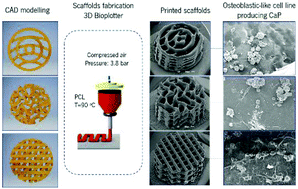Development of non-orthogonal 3D-printed scaffolds to enhance their osteogenic performance
Abstract
Three-dimensional (3D)-printed polycaprolactone (PCL)-based scaffolds have been extensively proposed for Tissue Engineering (TE) applications. Currently, the majority of the scaffolds produced are not representative of the complex arrangement of natural structures, since the internal morphologies follow an orthogonal and regular pattern. In order to produce scaffolds that more closely replicate the structure of the extracellular matrix (ECM) of tissues, herein both circular and sinusoidal scaffolds were fabricated and compared to their conventional orthogonal counterparts. This is an innovative, versatile and efficient strategy to 3D print PCL scaffolds with unique curved geometries. The morphology and the mechanical behavior of the scaffolds were assessed. The biological response was analyzed by evaluating the cell seeding efficiency, cell adhesion, proliferation, and osteogenic activity of an osteoblastic-like cell line seeded in these scaffolds. The scaffolds were designed and produced to have a similar porosity of about 56%. The non-orthogonal structures demonstrated lead to higher values of Young's modulus, both under dry conditions and when immersed in PBS. Moreover, the biological data corroborate that non-orthogonal scaffolds influence the cellular responses in a positive manner, namely in the osteogenic activity when compared with the orthogonal controls. These results suggest that introducing less orthogonal elements, which better mimic the tissue ECM and architecture, may have a positive influence on the cellular behavior, being a potential strategy to address bone tissue engineering applications.



 Please wait while we load your content...
Please wait while we load your content...